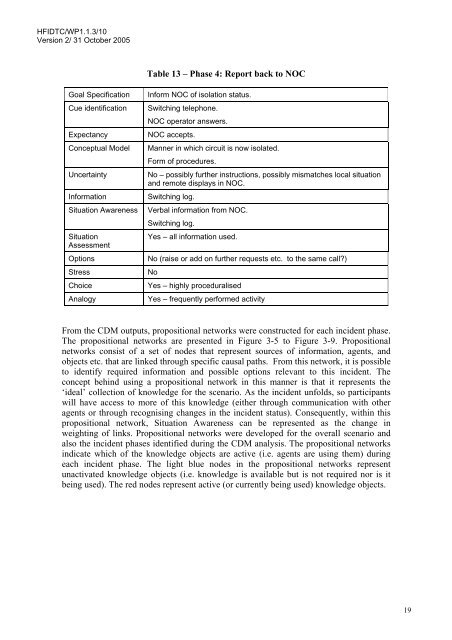A Review of the Event Analysis of Systemic Teamwork Methodology
A Review of the Event Analysis of Systemic Teamwork Methodology
A Review of the Event Analysis of Systemic Teamwork Methodology
- No tags were found...
You also want an ePaper? Increase the reach of your titles
YUMPU automatically turns print PDFs into web optimized ePapers that Google loves.
HFIDTC/WP1.1.3/10<br />
Version 2/ 31 October 2005<br />
Table 13 – Phase 4: Report back to NOC<br />
Goal Specification<br />
Cue identification<br />
Expectancy<br />
Conceptual Model<br />
Uncertainty<br />
Information<br />
Situation Awareness<br />
Situation<br />
Assessment<br />
Options<br />
Stress<br />
Choice<br />
Analogy<br />
Inform NOC <strong>of</strong> isolation status.<br />
Switching telephone.<br />
NOC operator answers.<br />
NOC accepts.<br />
Manner in which circuit is now isolated.<br />
Form <strong>of</strong> procedures.<br />
No – possibly fur<strong>the</strong>r instructions, possibly mismatches local situation<br />
and remote displays in NOC.<br />
Switching log.<br />
Verbal information from NOC.<br />
Switching log.<br />
Yes – all information used.<br />
No (raise or add on fur<strong>the</strong>r requests etc. to <strong>the</strong> same call)<br />
No<br />
Yes – highly proceduralised<br />
Yes – frequently performed activity<br />
From <strong>the</strong> CDM outputs, propositional networks were constructed for each incident phase.<br />
The propositional networks are presented in Figure 3-5 to Figure 3-9. Propositional<br />
networks consist <strong>of</strong> a set <strong>of</strong> nodes that represent sources <strong>of</strong> information, agents, and<br />
objects etc. that are linked through specific causal paths. From this network, it is possible<br />
to identify required information and possible options relevant to this incident. The<br />
concept behind using a propositional network in this manner is that it represents <strong>the</strong><br />
‘ideal’ collection <strong>of</strong> knowledge for <strong>the</strong> scenario. As <strong>the</strong> incident unfolds, so participants<br />
will have access to more <strong>of</strong> this knowledge (ei<strong>the</strong>r through communication with o<strong>the</strong>r<br />
agents or through recognising changes in <strong>the</strong> incident status). Consequently, within this<br />
propositional network, Situation Awareness can be represented as <strong>the</strong> change in<br />
weighting <strong>of</strong> links. Propositional networks were developed for <strong>the</strong> overall scenario and<br />
also <strong>the</strong> incident phases identified during <strong>the</strong> CDM analysis. The propositional networks<br />
indicate which <strong>of</strong> <strong>the</strong> knowledge objects are active (i.e. agents are using <strong>the</strong>m) during<br />
each incident phase. The light blue nodes in <strong>the</strong> propositional networks represent<br />
unactivated knowledge objects (i.e. knowledge is available but is not required nor is it<br />
being used). The red nodes represent active (or currently being used) knowledge objects.<br />
19
















